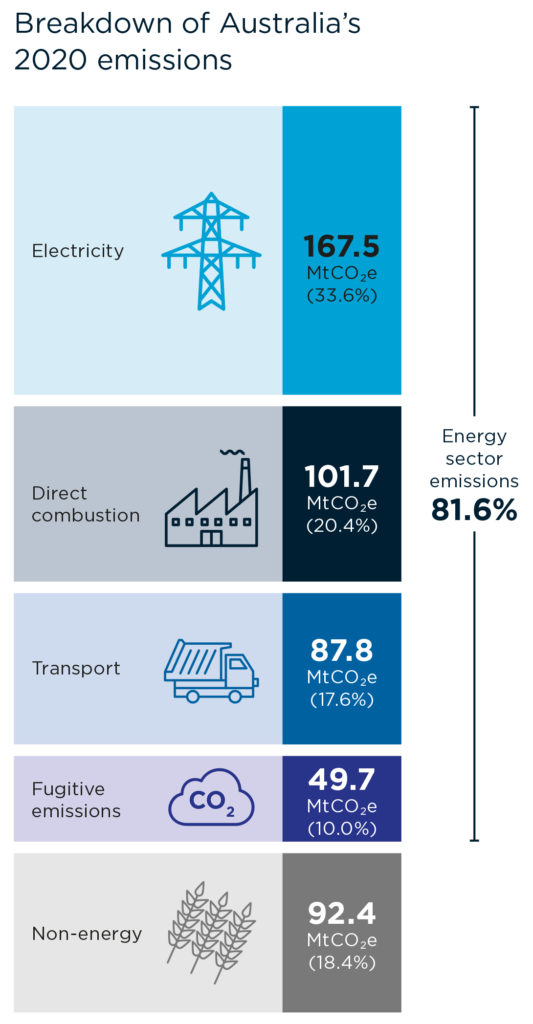It's a race to limit global average temperature rise to below 2°C. You might have heard the term ‘net zero emissions' a lot recently. It’s getting a lot of attention – and rightly so given its role in addressing climate change. But what does ‘net zero emissions' actually mean? And which technologies can we use to get there?
What does 'net zero' mean?
'Net zero' refers to a balance between the emissions we produce, and the emissions we can take out of the atmosphere. In order to have an overall (or 'net') balance of zero, we must ensure that one does not exceed the other.
You’ve probably encountered the term 'net' while doing your taxes. If we use that same logic, 'net zero' is the amount we're left with one all expenses and deductions have occurred.
Where do our emissions come from?
In Australia, the energy sector is responsible for most (about 82 per cent) of our emissions. The energy sector is made up of electricity, direct combustion – processes using heat or steam, often to produce steel and cement – transport, and fugitive emissions (any unintended emissions that occur during coal or gas extraction activities).
Outside of the energy sector, the rest of Australia’s emissions come from things like agriculture and waste.

Can we stop emitting right now?
Essentially, no. While the climate challenge is urgent, it is not practical for the entire world to stop emitting immediately. The transition is well underway and low emissions technologies are prospering, but we will still emit greenhouse gases for years to come through our everyday activities.
‘Net zero’ means that we can still produce some emissions. But we also need to ensure they're offset.
Step 1: Lower emissions
To quickly and effectively reach 'net zero', we must look at where we can limit emissions in the first place.
And it makes sense to initially focus on the energy sector. Not only because it's where most of Australia’s emissions come from, but also because it’s where the technology is most advanced.
Australia's electricity system is experiencing extremely rapid change. The proportion of electricity generated from renewable sources (like solar and wind) has been increasing over the last two decades. At the same time, large fossil-based energy sources are reaching the end of their lifespans. Energy efficiency improvements are also being realised in homes and commercial buildings.
If we can apply the same technological improvements to other sectors (like industry, transport and agriculture), we'll go a long way towards limiting overall emissions.
Step 2: Negative emissions
How can we extract greenhouse gas from the atmosphere? And where can we store it? Planting more trees and mangroves, plus avoiding deforestation is a good start.
But to make significant impact, we can look to technologies like direct air capture. This is where special chemicals ‘suck’ carbon dioxide out the of the air. This process mimics nature, where a tree would perform the same role.
With processes like carbon capture and storage, the carbon dioxide can be safely stored in geological formations kilometres below the ground. Or used in other industries that require carbon dioxide as an ingredient. We delve into negative emissions possibilities in this article.
Australia's net zero challenges and opportunities
Australia faces some challenges in the transition towards net zero emissions. The sheer size of our continent makes it difficult (and therefore emissions-intensive) to move people, goods and resources around the country.
Many of our traditional power sources are at end of life and our electricity grid is aging. We also depend on fossil fuel exports as a major part of our economy.
However, we do have a number of advantages and there are many reasons to feel positive.
We already have the highest per capita uptake of small-scale solar photovoltaics (PV) in the world. One in four Australian homes use solar technology. We have unmatched renewable energy resources (sunlight and wind). This makes us ideally placed to produce and export hydrogen. And our cutting-edge technologies position us very well to lead the way in driving emissions reduction across all sectors.
Transitioning to net zero emissions is a huge task. Meeting this challenge requires a range of technology solutions delivered at an unprecedented scale. As your national science agency, we’re working hard on the technology and making sure it can support an economically and socially-acceptable transition to a net zero emissions future.
